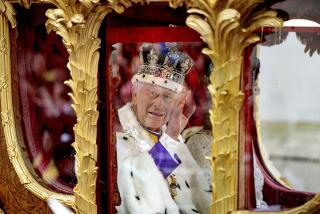Object of Veneration, Plunder and Legend : Truth Restored to St. Stephen’s Crown
- Share via
BUDAPEST, Hungary — After almost a millennium of turbulent Hungarian history, some of the myth has finally been separated from the reality of St. Stephen’s Crown--sapphires blazing against gold and enameled images of Byzantine rulers and Christian saints staring out impassively.
“No crown in Europe has had a stormier past or was more important for a pretender to possess--more important even than royal blood--if he wished to become king,” said Judit Kolba, an art historian of the National Museum in Budapest, where the crown is displayed.
Nor has any crown been more controversial. Revered as a mystical relic even though its authenticity has long been in dispute, the crown was largely off-limits to scholarly research until after World War II, apparently out of fear of losing the mystery that supported the monarchy.
The United States returned the crown seven years ago after holding it at Ft. Knox for about 30 years. Millions of Hungarians have since viewed the priceless relic--actually, it was once valued at $300 million--in its heavily guarded display case here. And at last the crown has been subjected to prodigious detective work by historians.
St. Stephen’s is not the oldest European crown; a circlet of a Lombard queen dating from the year 627 has that distinction. Nor is it the most magnificent; the crown of the 10th-Century Holy Roman emperor Otto the Great is accorded that honor.
Still, no European crown was in use longer, and none achieved the same importance in the political and legal development of a country. Justice was dispensed and laws passed “in the name of the Holy Crown,” not of the king.
Tradition long held that the crown was a coronation gift from Pope Sylvester II in 1001 to Stephen, the king who converted Hungary to Christianity. However, it is now certain that this crown never rested on Stephen’s head. Both the lower circlet and the upper arches were made about 100 years after his death, historian Kolba said.
Stephen did receive a crown from Sylvester, however. According to some scholars, the Vatican concocted the legend in the 13th Century to support its claim--over that of the Greek church in Constantinople--to primary influence in Hungary.
Kolba said the original crown, whose shape was depicted both on an altar cloth embroidered by Stephen’s wife and on gold coins dating from his reign, had the same helmet-like appearance as the present one, which is at least 800 years old.
At the top of the present crown is a curiously tilted cross, said by legend to be the result of a divine incident. Most likely, Kolba said, the gold arches supporting the cross were too pure or too thin to indefinitely hold the heavy cross erect.
“It could also have been improperly fitted. Almost every century, the crown was taken from Hungary but it was always returned through ransom, conquest or politics.
into its box,” a massive trunk, before the heavy lid closed on it, she added.
“There is nothing mystical about the crown,” Kolba said. “What is remarkable is that we have 800 years of history and tradition in one single object--this crown, which has been the accepted and unchallenged symbol of the Hungarian nation.”
Hungary’s history began in 896, when 50,000 pagan horsemen crossed the Carpathians and invaded the Danube basin. They were marauding nomads, part of the Finno-Ugric tribes from the western slopes of the Urals. The future Finns went northwest, while those who became the Hungarians migrated south along the Volga River.
The 10 conquering tribes were led by Arpad, whose great-grandson, Stephen, in 977 became their leader with the help of Bavarian Catholic knights. Stephen married a Bavarian princess and, according to Kolba, asked the Vatican for a crown to avoid becoming subservient to the powerful German emperor on his border. Stephen’s formal coronation was Christmas Day, 1001.
“His crown disappeared in the 12th Century, either stolen or destroyed, but it never reappeared,” Kolba said. “Nobody knows what happened to it, or precisely when, but we think now that, most probably, the present crown was fabricated at the direction of Bela III, who became king in 1173.”
Bela had been taken captive by Byzantine rulers to ensure Hungarian neutrality. He was raised in the Orthodox faith in Constantinople and eventually was designated to marry the emperor’s daughter and take the Byzantine throne. Late in life, however, the emperor had a son.
Bela was sent back to Hungary to become its king, but Hungarian nobles strongly opposed him, Kolba said, and Stephen’s Crown disappeared in an apparent effort to prevent his coronation.
Bela then had a replica made, and it gained not only acceptance but also new importance as the royal blood line died out and foreign kings vied for the Hungarian throne. None was recognized as legitimate until “Stephen’s crown” rested on his head.
“Almost every century the crown was taken from Hungary,” Kolba said, but it was always returned through ransom, conquest or political dispensation. Most recently, its guardians spirited it away from Budapest to prevent the Soviets from seizing it and then turned it over to U.S. forces in 1945.
The immediate postwar Communist government in Hungary rejected the initial U.S. offer to return the crown, along with other coronation regalia and the mummified right hand of St. Stephen, according to Kolba.
“The government then said, ‘We don’t need the crown,’ ” she said, with a small smile of irony.
Not long afterward, the same government strongly petitioned the United States for the crown that for centuries had been the prime legitimizing symbol of Hungarian rulers.
More to Read
Sign up for Essential California
The most important California stories and recommendations in your inbox every morning.
You may occasionally receive promotional content from the Los Angeles Times.













